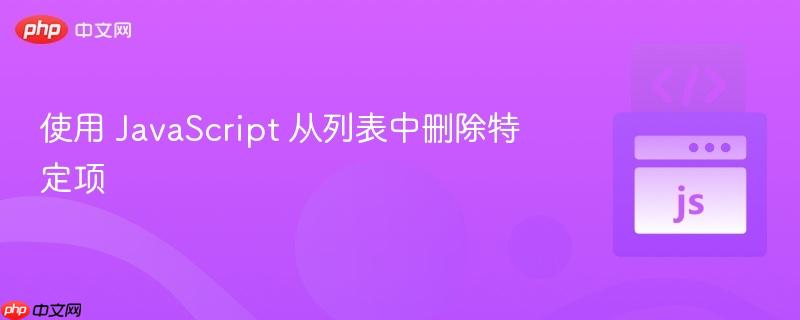
本文档旨在指导开发者如何使用 JavaScript 实现从列表中删除特定项的功能,而不是仅仅删除最后一项。我们将分析常见错误,并提供正确的实现方式,包括事件处理、索引查找以及数组操作,并提供完整的代码示例。
问题分析
初学者在实现列表项删除功能时,经常会遇到点击任何列表项都只删除最后一项的问题。这通常是由于以下原因造成的:
- 事件处理不当: onclick 事件直接绑定到包含所有列表项的容器上,而不是每个单独的列表项。
- 索引获取错误: 尝试获取要删除的元素的索引时,获取的是错误的值,或者根本没有正确获取到索引。
- splice() 方法使用不当: 即使获取了正确的索引,也可能因为 splice() 方法的使用方式不正确而导致删除错误。
正确的实现方式
以下是一个正确的实现方式,它解决了上述问题:
html 结构:
立即学习“Java免费学习笔记(深入)”;
<div class="container"> <h2>Shopping List</h2> <div class="header"> <input type="text" id="input" placeholder="Item"> <span onclick="updateList(myArray)" id="addBtn"><button>Add Item</button></span> </div> <ul id="itemList"></ul> </div>
JavaScript 代码:
let myArray = ["Sugar", "Milk", "Bread", "apples"]; let list1 = document.querySelector("#itemList"); // This function pushed my array items to create the list arrayList = (arr) => { list1.innerHTML = ''; // Clear the list before re-rendering arr.forEach(item => { let li = document.createElement('li'); li.textContent = item; li.addEventListener('click', deleteItem); // Add event listener to each list item list1.appendChild(li); }); } arrayList(myArray); //This function changed the background color of two of the list items to show that they are sold const idSelector = () => { let idElement = document.getElementsByTagName("li"); if (idElement.length > 0) { // Check if elements exist before accessing them idElement[0].style.color = "red"; if (idElement.length > 3) { idElement[3].style.color = "red"; } } } idSelector(); //This function uses the user input from the form to add items to the list updateList = (arr) => { let blue = document.getElementById("input").value; if (blue === "") { alert("Please enter a value if you wish to add something to your list.") } else { arr.push(blue); arrayList(myArray); // Re-render the list after adding idSelector(); document.getElementById("input").value = ""; // Clear the input field } } //This function is meant to delete the specified item chosen by the user from the shopping list and the array deleteItem = (event) => { let clk = event.target.textContent; // Get the text content of the clicked list item let index = myArray.indexOf(clk); if (index > -1) { myArray.splice(index, 1); } arrayList(myArray); // Re-render the list after deleting idSelector(); }
代码解释:
- 事件监听器: 在 arrayList 函数中,我们不再使用 onclick 属性,而是使用 addEventListener 方法将 deleteItem 函数绑定到每个 li 元素的 click 事件上。这确保了每个列表项都有自己的事件处理程序。
- 获取点击的元素: 在 deleteItem 函数中,event.target 指向实际点击的 li 元素。我们使用 event.target.textContent 获取该元素的文本内容。
- 查找索引: myArray.indexOf(clk) 查找数组中与点击的元素的文本内容相匹配的元素的索引。
- 删除元素: 如果找到了索引(index > -1),则使用 myArray.splice(index, 1) 从数组中删除该元素。 splice() 方法会修改原始数组。
- 重新渲染列表: 在删除元素后,需要重新渲染列表,以反映数组的更改。我们通过调用 arrayList(myArray) 来实现这一点。
- idSelector 函数的安全调用: 检查idElement的长度,防止访问不存在的元素。
关键点总结
- 事件绑定: 将事件监听器直接绑定到需要触发事件的元素上。
- 事件对象: 使用事件对象 (event) 获取有关触发事件的元素的详细信息。
- 数组操作: 使用 splice() 方法时,确保传递正确的索引和要删除的元素数量。
- 重新渲染: 在修改数据后,始终重新渲染 ui 以反映更改。
注意事项
- 唯一性: 如果列表项的内容不是唯一的,indexOf() 方法可能只会返回第一个匹配项的索引。 如果需要处理非唯一项,则需要使用更复杂的逻辑来确定要删除的正确元素。
- 性能: 对于大型列表,频繁的重新渲染可能会影响性能。 可以考虑使用更高效的更新 UI 的方法,例如使用虚拟 dom。
通过遵循这些步骤,您可以创建一个能够从列表中删除特定项的 JavaScript 程序。记住,理解每个步骤背后的原理是解决类似问题的关键。


